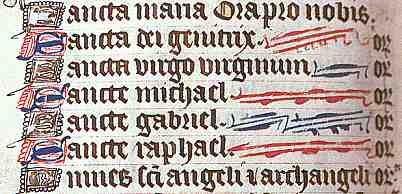Script Type : minuscule
Alternative Name : Black Letter Gothic
Date : 12th to 15th centuries, and beyond as a typeface. This is a 15th century example.
Location : Spread from France and the Low Countries across western Europe. This example is from Belgium.
Function : Book hand , this example being a formal specimen of the family of scripts.

























Distinctive letters : All letters have the characteristic of being very angular, with the bases of the letters finished off with little angular feet. Letters such as m, n, i and u are made up of series of hooked strokes called minims. This can make them hard to resolve in words such as uirginum or omnes, as seen in the example. There are two forms of r. The tall form of s hooks to the right at the base, and there is also the short curly form. The letters u and v are apparently distinguished from each other in this script, but this is a bit of an illusion as it is really a distincion between whether the letter occurs at the beginning or the middle of a word. The letters i and j are identical, or perhaps one could say that j has not been invented yet.
While the individual letters are boldly formed and well separated, certain combinations tend to be conjoined, such as
 ba
ba  de
de  do
do  pe
pe
There are several abbreviations in the example. The response ora pro nobis to the invocation of each saint in the litany has been reduced to a mere prompt after the first example.
Pass the cursor slowly along the lines of text to follow them. To examine another section of text from this book in more detail, proceed to the paleography exercises.
Paleography
exercises using Flash![]()
Requires at least the Flash 5 plugin
If you are looking at this page without frames, there is more information about medieval writing to be found by going to the home page (framed) or the site map (no frames).